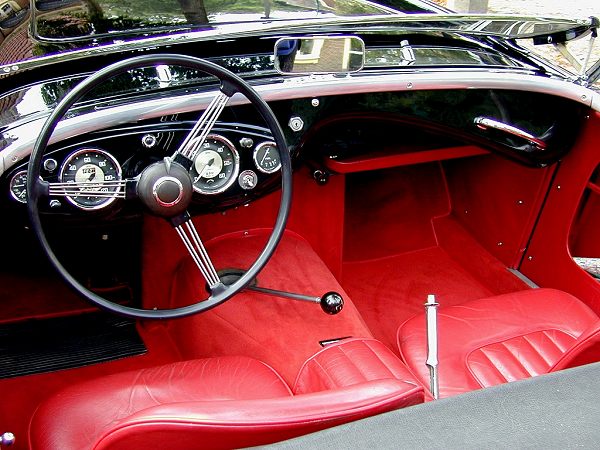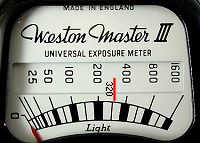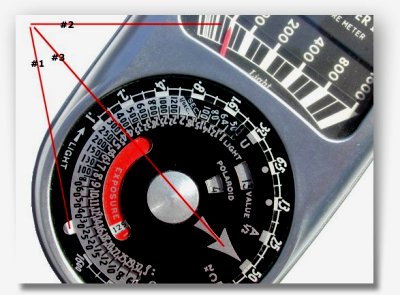|
Infoplus on Calibration WestonMaster and Euromaster series. by John D de Vries. © 2000, 2001,2002,2003 (JDesq, Driebergen)
|
|
Exposure-Meter Calibration.
|
|
3 Steps to correct exposure
After these 3 steps all Apertures are locked to their corresponding Exposuretimes! |
|
Converting to Cd/ft2
The Exposure Formula. A formula exists which, once learned, facilitates rapid exposure calculation mentally, without the need for setting dials on meters. It requires knowing luminance values in candles per square-foot, and unfortunately few, if any meters today are calibrated in these units.
Since the early Weston Master meters read directly in Cd/ft2, very rapid exposure determination was possible. Current meters can usually be calibrated in these units to facilitate the use of the Exposure-formula, as described below.(See Converting to candles per square foot above)
To use the Exposure Formula, take the film speed number of the film you're using in ISO or ASA and determine its approximate square root. This number is remembered as the Key Stop for that particular E.I. For example, a film rated as ASA 125 has a key stop of f/11.
At the key stop, the correct shutter speed in seconds to expose a given luminance on Zone V [Kodak 18 % Neutral Grey Card], is the reciprocal of the luminance expressed in Cd/ft2.
Thus for a surface that measures 60 Cd/ft2, we would use a shutter speed of 1/60 second at the key- stop. In a typical situation, you might visualize a certain area as a Value III in the print and find that its luminance is 30 Cd/ft2. If this value is placed on Zone III, then 60 Cd/ft2 falls on Zone IV and thus 120 Cd/ft2 on Zone V. Your exposure then is 1/125 at the key-stop, or any equivalent combination.
Resuming, the Exposure Formula thus permits very rapid calculation of exposure without reference to the meter's rotating dial. Hence, you will have to compute a little more , when you don't have a scale calibrated in Cd/ft2. An example....
You're using a film rated at 400 ISO, thus the keystop will be f/22, which you will set accordingly to your Camera lens. For a surface that measures 13 and placed on Zone V, this will give you a luminance of 200 Cd/ft2 ( 10=25, 11=50, 12=100, 13=200). Your final exposure time will be thus 1/250 second at the key-stop, which we defined as f/22.
|

Another Legend...Note the Weston amp. meter
Spectral Sensitivity Range of the Exposure Meters
JohnDesq's Bench

 When it is properly calibrated, the photographer can expect his exposure meter to measure light that will ultimately be viewed by the camera.
The first step is to check your exposuremeter calibration. It is important to be sure that the pointer is reading zero before checking your instrument. To ensure this, cover the photoelectric cell with your hand, hold the instrument in the position in which it is normally used, and note the position of the pointer. If it points away from the zero position, it should be returned to zero by means of the small zero corrector near the lanyard assembly.
Take a reading on a clear north sky any time between 10 A.M and 2 P.M. It is important that there be no clouds or haze in the sky, because this will of course make a considerable vibration in the reading. However on a day when the sky is blue and free from haze you should expect approximately 320 candles per square foot, or if your instrument is calibrated in other values, this light should result in an exposure of approximately f/16.5 at 1/100, ASA/ISO speed number 100. [ EV 15 ]
Slight deviations from the value above can be disregarded: pecularities of atmospheric conditions can cause variations of 1/3 below or above normal.
When it is properly calibrated, the photographer can expect his exposure meter to measure light that will ultimately be viewed by the camera.
The first step is to check your exposuremeter calibration. It is important to be sure that the pointer is reading zero before checking your instrument. To ensure this, cover the photoelectric cell with your hand, hold the instrument in the position in which it is normally used, and note the position of the pointer. If it points away from the zero position, it should be returned to zero by means of the small zero corrector near the lanyard assembly.
Take a reading on a clear north sky any time between 10 A.M and 2 P.M. It is important that there be no clouds or haze in the sky, because this will of course make a considerable vibration in the reading. However on a day when the sky is blue and free from haze you should expect approximately 320 candles per square foot, or if your instrument is calibrated in other values, this light should result in an exposure of approximately f/16.5 at 1/100, ASA/ISO speed number 100. [ EV 15 ]
Slight deviations from the value above can be disregarded: pecularities of atmospheric conditions can cause variations of 1/3 below or above normal.
 This will be true only for Euromaster II. Note the scale in the high scale position i.e with the baffle closed, this will run from 10 - 16. Now memorize 10 is 25 c/ft2, double this for each next number on the scale. Resuming 16 will be 1600 c/ft2.
On the Low scale position, showing 1 - 10, you will half these values so 9 will be 12.5 Cd/ft2, 8 will be 6.5 Cd/ft2 and so forth. To convert from here to Foot-lamberts multiply by pi which means that a scale reading of say 8 (6.5 c/ft2) represents about 20 foot lamberts, which is satisfactory for domestic slide or film projection.(Screen luminance).
This will be true only for Euromaster II. Note the scale in the high scale position i.e with the baffle closed, this will run from 10 - 16. Now memorize 10 is 25 c/ft2, double this for each next number on the scale. Resuming 16 will be 1600 c/ft2.
On the Low scale position, showing 1 - 10, you will half these values so 9 will be 12.5 Cd/ft2, 8 will be 6.5 Cd/ft2 and so forth. To convert from here to Foot-lamberts multiply by pi which means that a scale reading of say 8 (6.5 c/ft2) represents about 20 foot lamberts, which is satisfactory for domestic slide or film projection.(Screen luminance).